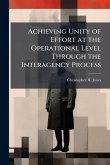In an age predominated by states but rife with non-state actors, failing states, increasingly fluid boundaries, disenfranchised yet interconnected populations, and increasingly self-aware cultures, the United States must develop a foreign policy structure that is adaptive to these circumstances. This foreign policy structure must be able to leverage the unique and varied technical capabilities of the United States and be able to apply them to diverse cultures across the globe. It must be able to win over allies and partners to gain regional influence and appeal. It must be able to leverage relationships with regional partners and entities through prolonged presence built into trust. When action is required, it must be flexible enough to respond across a range of responses from strictly civilian capabilities to military action. Finally, it must be able to act with the full support and confidence of the President and possess the responsibility and accountability to match. This research demonstrates the current foreign policy architecture does not possess the capacity required to meet this challenge. Likewise, the current reforms both within the military and within the interagency are insufficient to the tasks required. As a result, it is necessary to reform the interagency to be able to adequately match the desired ends of the National Security Strategy with more agile and diverse ways and means. This research proposes developing Regional Interagency Consulates with an Ambassador in charge and a military deputy that is dual-hatted as the Regional Combatant Commander. It contains functional Assistant Secretaries with staffs from most Cabinets and many executive agencies and government corporations. It meets the aforementioned challenges by being robust enough to offer the President options, both military and non-military, to prevent crises from occurring and to respond if they occur. It can operate in a state construct just as easily as in a construct of sub-national This work has been selected by scholars as being culturally important, and is part of the knowledge base of civilization as we know it. This work was reproduced from the original artifact, and remains as true to the original work as possible. Therefore, you will see the original copyright references, library stamps (as most of these works have been housed in our most important libraries around the world), and other notations in the work. This work is in the public domain in the United States of America, and possibly other nations. Within the United States, you may freely copy and distribute this work, as no entity (individual or corporate) has a copyright on the body of the work. As a reproduction of a historical artifact, this work may contain missing or blurred pages, poor pictures, errant marks, etc. Scholars believe, and we concur, that this work is important enough to be preserved, reproduced, and made generally available to the public. We appreciate your support of the preservation process, and thank you for being an important part of keeping this knowledge alive and relevant.
Bitte wählen Sie Ihr Anliegen aus.
Rechnungen
Retourenschein anfordern
Bestellstatus
Storno








